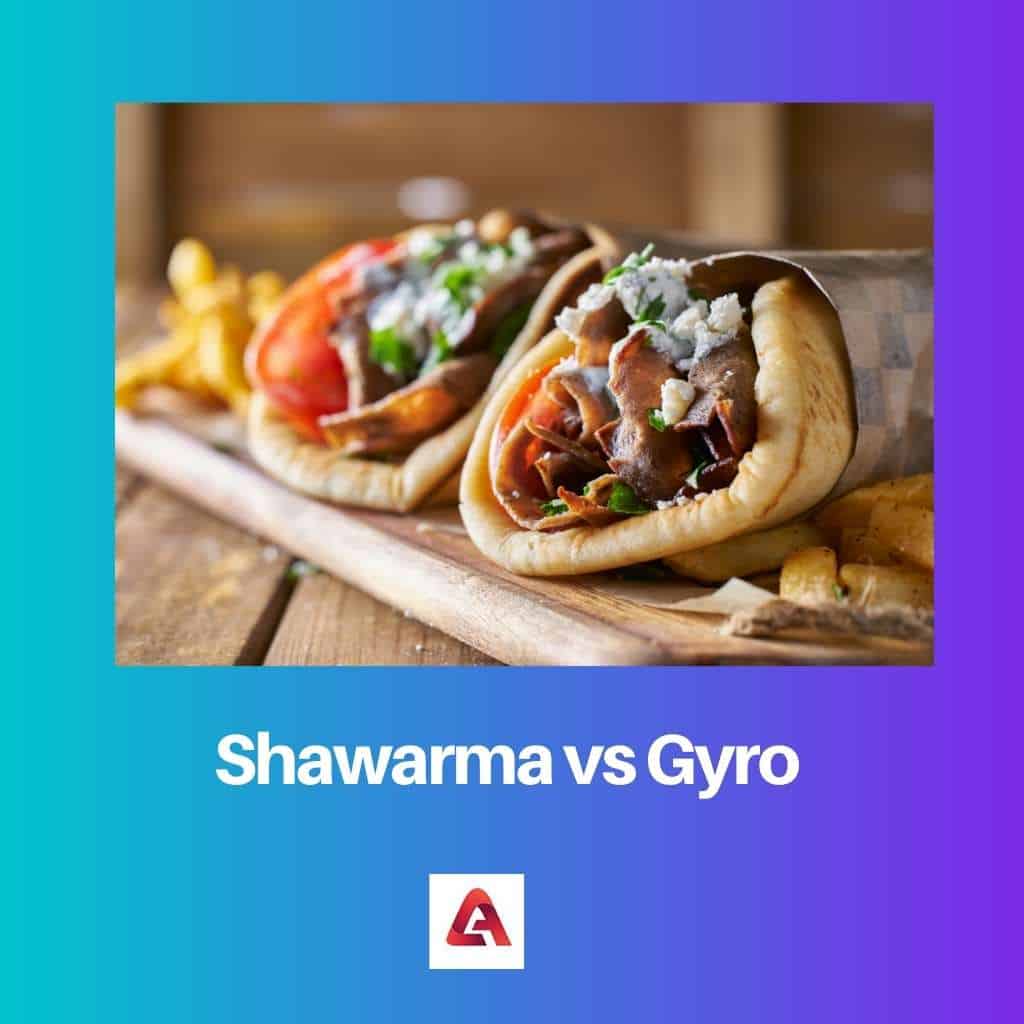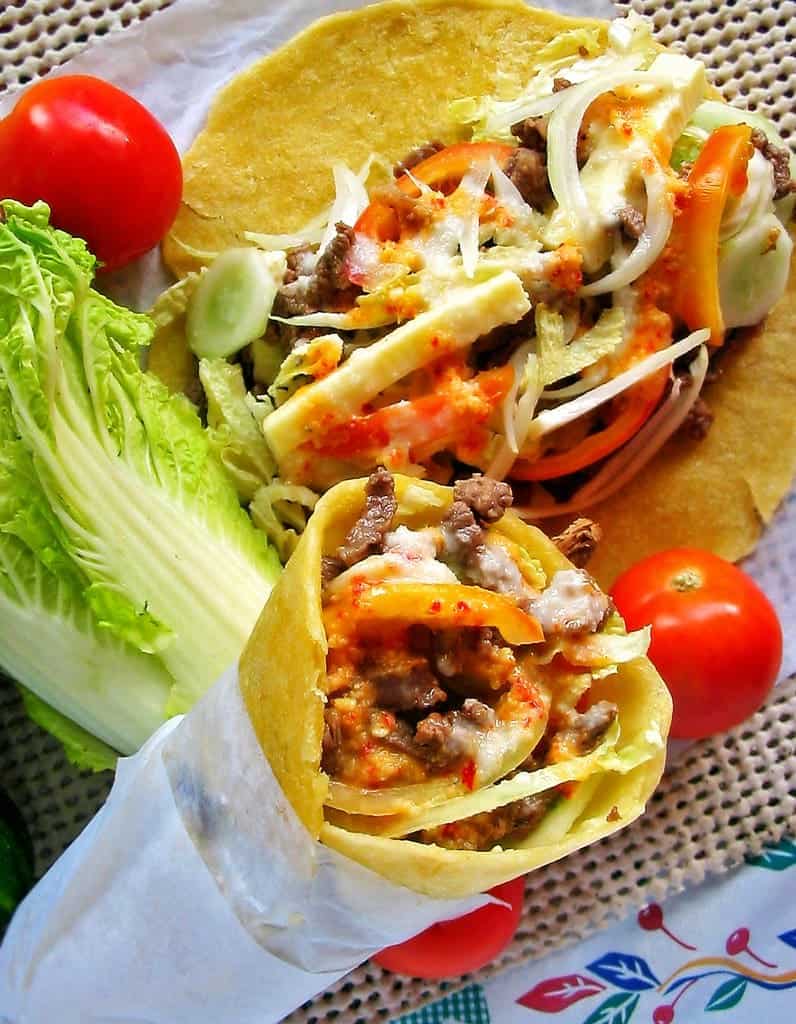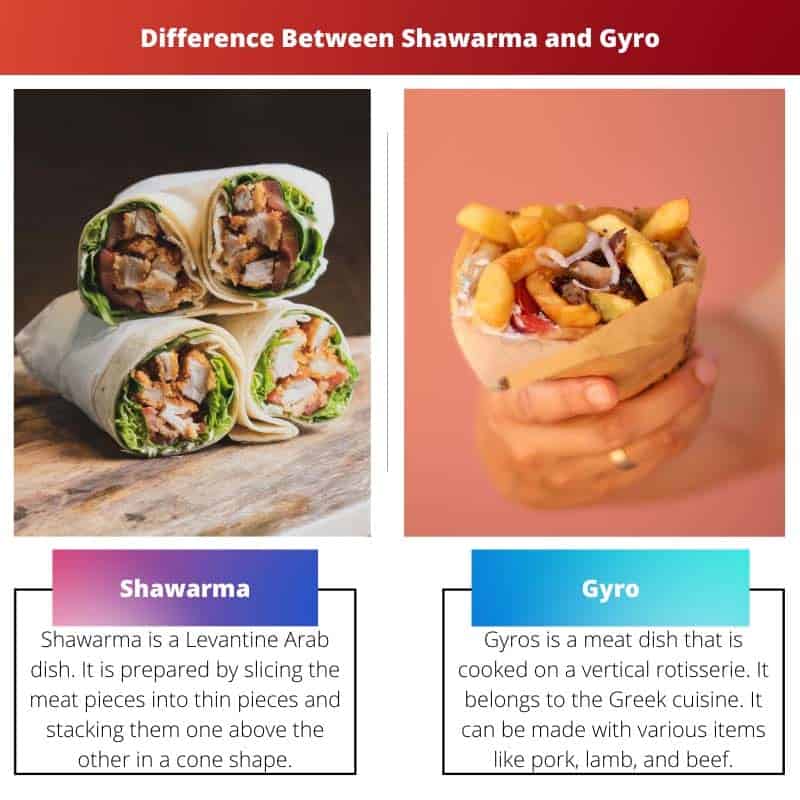The discovery of fire led to the cooking and roasting of food on a stick over flames. Right from the medieval period, roasting meat on a rotisserie had been done.
This spit-roasted meat grew majorly later in Turkey as Doner kebab. Doner kebab can be further classified into two types is Shawarma and Gyro.
Key Takeaways
- Shawarma is a Middle Eastern dish made from marinated and slow-roasted meat, such as chicken, lamb, or beef, sliced thinly and served in a wrap or pita bread.
- Gyro, originating from Greece, consists of seasoned meat, pork, chicken, or lamb, cooked on a vertical rotisserie and served with pita bread, vegetables, and tzatziki sauce.
- While both dishes feature seasoned, rotisserie-cooked meat, shawarma has Middle Eastern spices and flavors, and gyro has Greek influences and distinctive accompaniments.
Shawarma vs Gyro
Shawarma is a dish that consists of marinated meat, chicken, beef, or lamb, that is stacked on a vertical spit and slowly roasted. Gyro is a Greek dish that is similar to shawarma, but consists of thinly sliced meat that is cooked on a vertical spit and then served in a pita bread or wrap.

Shawarma was first prepared by Iskender Efendi in the year 1870. The origin of the dish is from Ottoman Empire.
It is prepared by slicing the meat pieces into thin pieces and stacking them one above the other in a cone shape. It can be prepared with various kinds of meat like chicken, lamb, mutton, beef, turkey, and even veal.
On the other hand, the gyro was prepared even in the army of Alexander. The dish was popularised during the 19th century.
The wrapped sandwich of Greek cuisine can be prepared with pork, lamb, and beef. It is stuffed in pita bread with crispy French fries and topped with onion, tomato, and yogurt sauce.
Comparison Table
| Parameters of Comparison | Shawarma | Gyro |
|---|---|---|
| Origin of dish | Ottoman empire | Greece |
| Type of dish | Levantine Arab dish | Greek dish |
| Other names | Shaurma, chawarma, showarma, and others | Gyros, yiros |
| Spices ingredients | Garlic, cinnamon, cardamom, cloves, turmeric, and curry | Thyme, cumin, Rosemary, oregano |
| Filling ingredients | Hummus, salad, tahini, and pickles | Onion, shredded lettuce, tomato, yogurt sauce called tzatziki, and French fries. |
What is Shawarma?
Shawarma is a Levantine Arab dish. It is prepared by slicing the meat pieces into thin pieces and stacking them one above the other in a cone shape.
The stacking of the meat pieces is done on a Vertical rotisserie or also known as spit, which turns slowly.
Initially, shawarma was made of chicken, lamb, or mutton while now it is available in other varieties like beef, Turkey, and even veal.
The origin of the dish is from Ottoman Empire. It is popular street food in Egypt, the Arabian Peninsula, Levant, and other places in the Middle East.
The derivation of the word shawarma is from the Turkish word “Çevirme” which means turning.
The turning movement is referred to as the rotisserie.
The shawarma technique includes grilling of the vertical stack of meat and as it cooks, pieces of meats are cut out. Shawarma was also referred to as a form of Doner kebab.
Shawarma also forms the basis of a contemporary Mexican dish called tacos al pastor in the early 20th century. It was brought about by Lebanese immigrants.
The preparation technique of shawarma includes thin slices of meat which is seasoned and marinated. These pieces are stacked on a skewer which has a height of about 20 inches.
Fat pieces can also be added to the stack to enhance the flavor and juiciness. The spit is motorized and rotates slowly in a gas-fired heating element and roasts the outer layer.
For serving, pieces of meat are shaved with a long flat knife.

What is Gyro?
Gyros is a meat dish that is cooked on a vertical rotisserie. It belongs to the Greek cuisine. It can be made with various items like pork, lamb, and beef.
The serving pattern of gyros is stuffed or wrapped in pita bread. It is accompanied with onion, tomato, fried potatoes, and even tzatziki.
Gyros fall under the main course category of food. The technique of stacking meat and grilling them over a vertical spit, and then shaving off as it cooks was popularised during the 19th century.
During World War 2, such a technique was extensively carried out in Athens with lamb. The Greek variation included pork and tzatziki which became renowned as gyros.
The wrapped sandwiches are a common street food or fast food in Athens, New York, and Chicago. The derivation of the name is from a Greek word that implies turn or cycle.
The seasoning of the meat pieces includes thyme, cumin, Rosemary, oregano, and others. The pronunciation of Gyro is “yee-row” or “year-oh”.
Greek historians have found pieces of evidence of the dish in the army of Alexander through lines like “skewered their meet on long knives” and “repeatedly turned over and cooked in open fire”.
The origin of the sandwich is about 2000 years ago but have caught the attention of the mass. Greek gyro includes pork while American Gyro includes lamb or beef.
The highest taste of gyro is achieved when it is stuffed in pita bread and piled with crispy French fries and topped with onion, tomato, and yogurt sauce.
It is a messy sandwich that is reasonably priced and heavily consumed by fast eaters.

Main Differences Between Shawarma and Gyro
- Shawarma can be made of chicken, lamb, mutton, beef, turkey, and even veal while Gyro can be made of only pork, lamb, and beef.
- Shawarma is not served with any toppings while Gyro is served with various toppings like onion, tomato, yogurt sauce called tzatziki, and French fries.
- The meat of Shawarma is kept marinated for as long as a day while the meat of Gyro is kept marinated for a short period.
- Shawarma may or may not be served with pita bread while Gyros is always served with pita bread.
- The preparation method of Shawarma includes tahini while Gyro does not include tahini.




